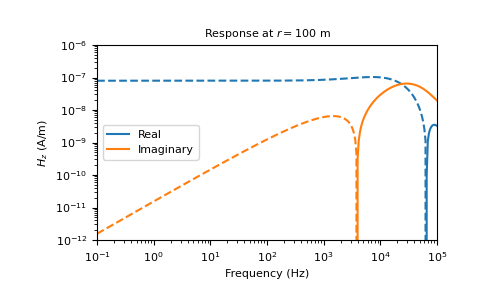simpeg.electromagnetics.analytics.hzAnalyticDipoleF#
- simpeg.electromagnetics.analytics.hzAnalyticDipoleF(r, freq, sigma, secondary=True, mu=1.25663706127e-06)[source]#
The analytical expression is given in Equation 4.56 in Ward and Hohmann, 1988, and the example reproduces their Figure 4.2.
Examples
>>> import matplotlib.pyplot as plt >>> from simpeg import electromagnetics as em >>> freq = np.logspace(-1, 5, 301) >>> test = em.analytics.hzAnalyticDipoleF( >>> 100, freq, 0.01, secondary=False) >>> plt.loglog(freq, test.real, 'C0-', label='Real') >>> plt.loglog(freq, -test.real, 'C0--') >>> plt.loglog(freq, test.imag, 'C1-', label='Imaginary') >>> plt.loglog(freq, -test.imag, 'C1--') >>> plt.title('Response at $r=100$ m') >>> plt.xlim([1e-1, 1e5]) >>> plt.ylim([1e-12, 1e-6]) >>> plt.xlabel('Frequency (Hz)') >>> plt.ylabel('$H_z$ (A/m)') >>> plt.legend(loc=6) >>> plt.show()
(
Source code,png,pdf)
Reference
Ward, S. H., and G. W. Hohmann, 1988, Electromagnetic theory for geophysical applications, Chapter 4 of Electromagnetic Methods in Applied Geophysics: SEG, Investigations in Geophysics No. 3, 130–311; DOI: 10.1190/1.9781560802631.ch4.
